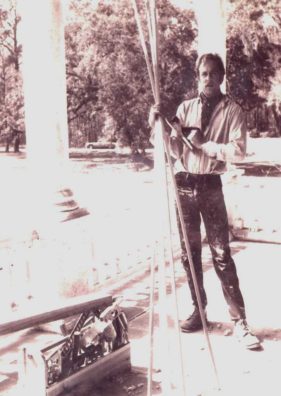Voted the Best Place to See by Condé Nast Traveler.


The morning of February 27th, 1980 dawned cold and clear, with temperatures below freezing. Stephen Wood drove for miles that morning in the dappled sunlight streaming through the live oak trees that stretch their branches over Ashley River Road, now a South Carolina Scenic Byway. His destination was Murray’s Sand Company on the outskirts of Summerville. Stephen purchased sand for a new campaign of preservation work at Drayton Hall and noted that one could also buy crawfish there (when in season). Purchase completed, Stephen folded his 6’2” frame back into his red Datsun pickup truck and drove to Drayton Hall. He followed the main entrance road down a hill before turning his truck onto a narrow path through the forest that led to the old barn. He stored the sand in the barn and then made his way to the main house.
It was the first day of the 1980 Restoration Workshop at Drayton Hall. The workshop was a training program for preservation-minded tradespeople run by the National Trust for Historic Preservation. Stephen–27 years old with a degree in American History and several years of hands-on training in historic building trades–hoped that his time at Drayton Hall might lead to a permanent position there and planned to discuss the matter with leadership later in the spring. Despite the chilly start that day, temperatures climbed steadily until they reached a comfortable 61 degrees—perfect weather for working in an attic that could otherwise have been oppressively hot, given the fickle nature of weather conditions in Charleston. Stephen spent most of the day in the attic, rebuilding a ladder that led to the access hatch in the roof, installing some flooring to make traversing the space less harrowing, and making note of repairs that would need to be made to the framing.
Such details come primarily from the daybook Stephen kept during his five months working at Drayton Hall in 1980. Evidence of his work is still seen on the chimney caps, the riverfront stairs, exterior stonework, and more. Stephen made notes on all of these projects, pausing each afternoon to scrawl a few sentences about the tasks on which he’d made progress, the weather, an occasional note about his personal life, and his philosophical musings about preservation. By all accounts, he was very proud of his work at Drayton Hall, and took seriously the idea that the site should be carefully conserved and stabilized–rather than restored.
The contents of this daybook, along with other documents from the Drayton Hall archives, offer an engaging glimpse into the ideas and aspirations of a talented young preservation professional whose life was cut tragically short. On August 5th, at 10:30 in the morning, Stephen was joined on site by Alan Keiser, the director of the Restoration Workshop, who came to help him dismantle the scaffolding on the house which they had used to access the roof. That afternoon, the section of scaffolding they were working on failed catastrophically, throwing the men to the ground. Alan Keiser suffered serious injuries but survived. Stephen’s injuries were more severe, and he died at a local hospital a few hours later.
In 2005, Stephen’s brother, Anthony Wood, established the Wood Family Fellowship in honor of Stephen’s passion for preservation and their parents’ love of history and affinity for Drayton Hall. The fellowship brings a young preservation professional to Drayton Hall each year to learn and to help advance our mission. As this year marks the 40th anniversary of the accident that took Stephen’s life, and the 15th year of the Wood Family Fellowship, we have created this online exhibit to honor Stephen Wood’s contributions to Drayton Hall and to the field of historic preservation, and to explore his legacy through the lens of all the subsequent preservation work that sought to meet his exacting standards.
Stephen Wood’s friend and mentor, Peter W. Cook, penned a fitting prologue to this exhibit in his reflections on Stephen’s life: “Something about the tip of an iceberg comes to mind…”